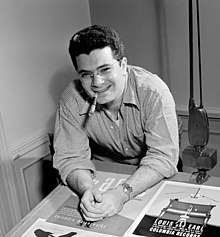Alex Steinweiss
Alex Steinweiss (born March 24, 1917 in Brooklyn , New York City , New York , † July 17, 2011 in Sarasota , Florida ) was an American graphic designer . He is considered the inventor of the record cover .
Career
Steinweiss started his own business in 1939 after training at the Parsons School of Design and in Joseph Binder's graphic studio , where Steinweiss worked as an assistant from 1937. Shortly thereafter, he applied to the Columbia label in Bridgeport, Connecticut.
Shortly after starting his own business, he heard about the position as art director at the new record company Columbia Records , which he also received. It was there in 1940 that he had the idea of a special design for the previously unprinted packaging for records. He created a design for the LP Smash song hits by Rodgers & Hart , released in February 1940 . The significantly better sales success of records with attractively designed sleeves quickly turned this idea into an economically important branch of design art.
Until about 1945 Steinweiss was the sole designer for record sleeves at Columbia Records ; in later years the team expanded. Steinweiss also worked for other record labels such as Decca Records , London Records and Everest Records in the course of his career . With over a thousand record sleeves, he shaped the visual appearance of musical interpretations in jazz, classical and pop.
The first shellac record for which Steinweiss designed a record cover was in 1940 a recording by the songwriters Richard Rodgers and Lorenz Hart , Smash Song Hits . Steinweiss drove to New York's Imperial Theater on 45th Street for the photo and persuaded the owner to set the illuminated panel for an hour so that his team could photograph the Rodgers and Hart lettering . The photo of the neon sign with the background of a graphic representation of a record was the motif of the first record sleeve.
Another cover that the design pioneer created for Beethoven's 5th Piano Concerto is a prime example of Steinweiss' ability to give the music a face with his motifs - and how far his influence went on the cover design. On the cover, a bundled beam of light falls on a wing against a pitch black background, is deflected as if by a prism and fans out into the colors of the rainbow. More than 30 years later, British design studio Hipgnosis quoted this motif on the cover of Pink Floyd's The Dark Side of the Moon from 1973.
A bizarre artifact of his work is the draft for an album entitled Battle at Thunderblow . The cover shows two buttocks, between them a cloud of haze from intestinal winds. The noises of a farting competition could be heard on the record. The publication was to be given away in 1946 in a strictly limited edition of 100 copies as a dealer bonus. But then Columbia boss Wallerstein banned the project before it became public.
In 1972, the design revolutionary decided to retire from the business at the age of 55. “One day I was waiting in the reception area of a record company - me in a suit, next to me a lot of long-haired guys in fringed leather jackets. It was then that I realized that I was totally old-fashioned and that it was time to throw in the towel. ”Steinweiss stayed true to the close connection between music and motif. Under the stage name Piedra Blanca (the Spanish terms for "stone" and "white") he began to paint series of paintings based on the masterpieces of famous composers.
He died on July 17, 2011 at his Sarasota, Florida home at the age of 94.
literature
- Kevin Reagan, Steven Heller, Alex Steinweiss: Alex Steinweiss, The Inventor of the Modern Album Cover Taschen, Hong Kong, ISBN 978-3-8365-0192-7 . (multilingual, mainly photos of his record covers)
Web links
- Literature by and about Alex Steinweiss in the catalog of the German National Library
- 100th birthday of Alex Steinweiss - the inventor of the modern record cover on Deutschlandfunk from March 24th 2017.
- Inventor of the record cover - The one with the colors danced on SPON one day on November 20, 2009.
Individual evidence
- ^ Obituary in The New York Times
- ↑ Michail Hengstenberg: Record cover inventor Alex Steinweiss dies - farewell to the cover lover , Spiegel-Online from July 20, 2011
- ↑ Binder's innovative spirit, the use of then little-known stylistic devices such as airbrush technology and his principle "Design is communication, presentation and motivation" had a lasting impact on Steinweiss. See Thomas Wyss: The man who made the music world more colorful, Tages-Anzeiger , August 8, 2011.
- ^ Stanford University with discography
- ↑ Christian Meyer in Süddeutsche Zeitung of November 6, 2009, p. 10 - article online: The veil artist
- ↑ The cover design turned out to be very effective; sales were 895 percent higher than comparable records. Cf. Thomas Wyss The Man Who Made the Music World More Colorful, Tagesanzeiger, August 8, 2011
- ↑ Taschen Verlag: In Memory of Alex Steinweiss (1917–2011)
| personal data | |
|---|---|
| SURNAME | Stone white, Alex |
| BRIEF DESCRIPTION | American designer, inventor of the record cover |
| DATE OF BIRTH | March 24, 1917 |
| PLACE OF BIRTH | Brooklyn , New York |
| DATE OF DEATH | July 17, 2011 |
| Place of death | Sarasota , Florida |
